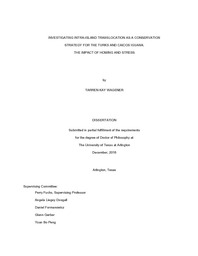| dc.description.abstract | The Turks and Caicos iguana, Cyclura carinata, is listed as critically endangered by the International Union for the Conservation of Nature due to introduced mammals and habitat alteration from human development. Inter-island translocations are a key conservation strategy for the species and, while resource intensive, have been successful to date. However suitable islands for translocation (good habitat and free of mammals) are scarce despite a surplus of animals threatened by human development. Intra-island translocation strategies that complement human needs must be found. Big Ambergris Cay (supporting the single largest remaining population of TCI iguanas) presents a unique opportunity to determine the effectiveness of intra-island translocations while also mitigating specific threats facing the significant iguana population there. However, factors affecting the success of translocations include post-translocation stress and homing behavior. This study documented these variables by systematically manipulating the sex, age, and time of year moved for 96 subject animals. Outcome measures include corticosterone concentrations, leukocyte profiles, movement patterns and homing tendencies. Results indicate that there was a significant effect of translocation on baseline corticosterone concentrations. For adults, corticosterone concentrations significantly increased as a result of translocation, nearly doubling over initial levels at the final catch. There were no significant differences in baseline corticosterone values across the movement periods based on gender or season. Capture-stress induced corticosterone and H:L values also increased significantly over time, and there was a significant main effect of gender, with adult females exhibiting higher corticosterone concentrations than adult males and adult males exhibiting higher H:L ratios than adult females. While displaying some evidence of altered HPA axis functioning, subjects of both genders displayed an ability to continue to mount an appropriate stress response. Body condition scores decreased significantly on average across all subjects as a result of translocation. Across all ages, sexes and seasons, subjects traveled further during the translocation period than the baseline period. Adults moved more total distance than juveniles in both the baseline and translocation periods, though the difference between the two age classes was considerably more during the translocation period. During the translocation period, males traveled significantly more total distance than females across both age classes. Adults also moved significantly further per average movement compared to juveniles during the translocation period. Within juveniles, females moved further than males in a single foray between two consecutive locations across both movement periods. During the baseline period, adult and juvenile home ranges were similar in size and very small. Among subjects that did not successfully home after translocation, adults traveled significantly further towards their original capture site than juveniles. There were effects of season on movement patterns during the baseline period only. Across all ages and genders, subjects moved significantly more total distance, covered more area and traveled further per movement during the baseline period of the wet season than the dry season. Adults of both sexes attempted to home, successfully homed, and did so in both the wet and dry seasons. No juveniles homed. Adult males homed faster than females, and the ability to home did significantly impact corticosterone concentrations. With the exception of maximum distance between consecutive points, animals that homed did not significantly differ in total distance moved or minimum convex polygon measures of displacement range. This study represents the first systematic test of homing abilities in a Cyclura species, as well as the first Cyclura translocation project to utilize juveniles. It is hoped that results of this study add to the allied literature by providing a systematic test of the effects of homing and post-translocation stress on intra-island translocation methods that can be utilized to promote iguana-friendly development throughout the region. | |


